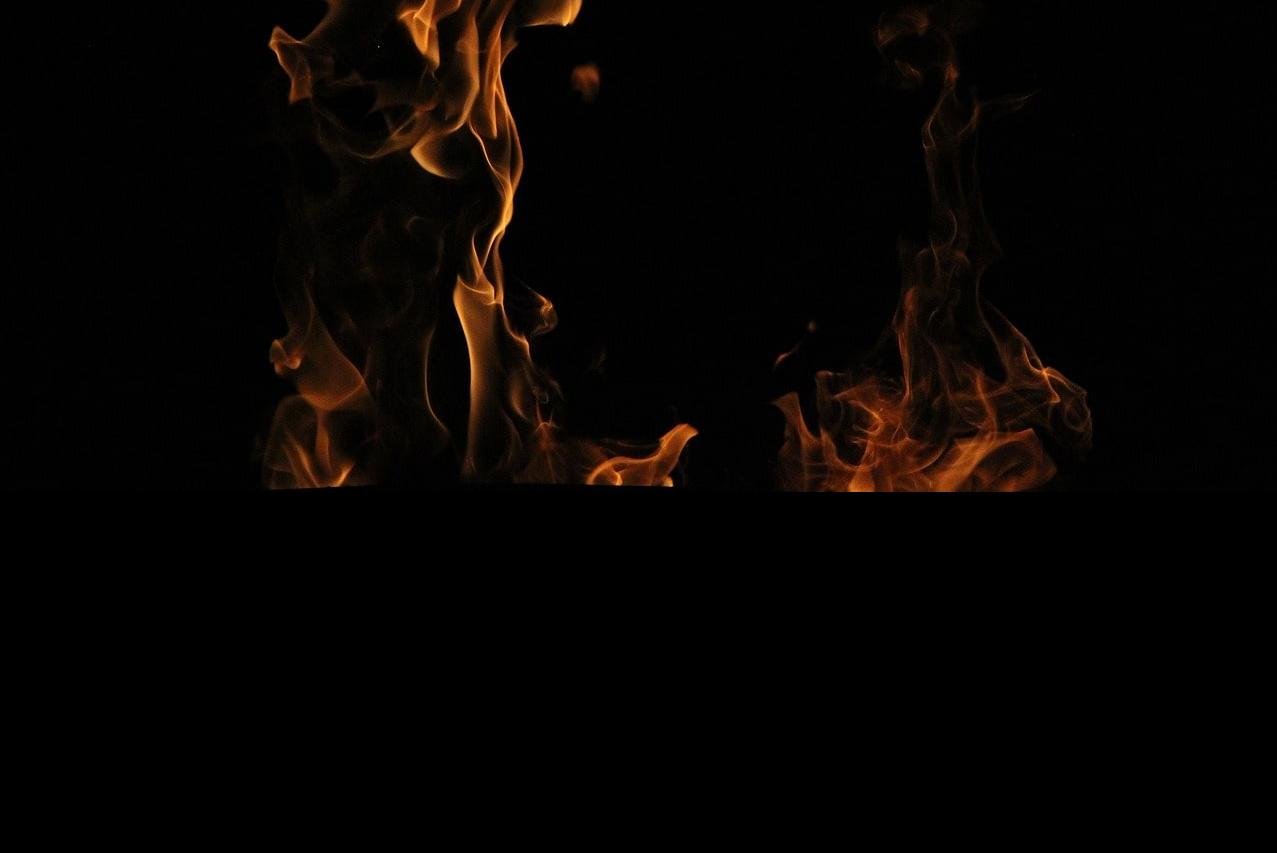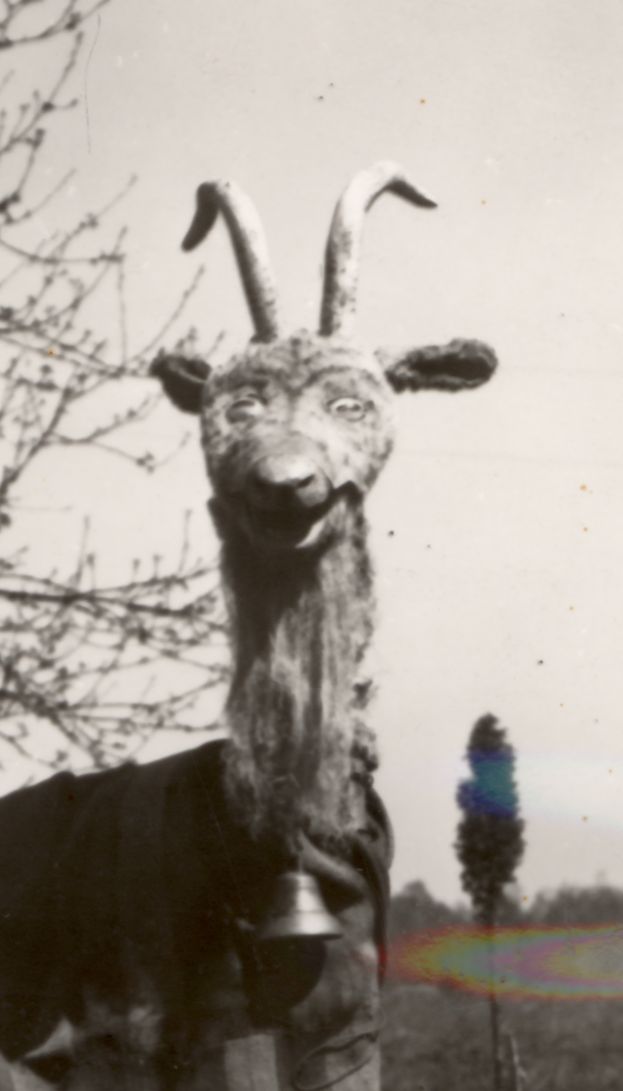Masking traditions
In Estonia, house-to-house processions of disguised young people occurred during several late autumn and winter holidays, including Christmas and New Year. In the olden days they probably mainly disguised themselves as animals and birds, later simply as furry and ugly creatures. Hair, straw and a horrible appearance symbolized both supernatural origin and fertility. The mysterious creatures might also represent ancestors visiting the home, the mores so, that the Souls' Time occurs in the same season. The masked guests blessed farmhouses and received gifts in return, which were concurrently offerings to the supernatural world and gifts to the members of their community.
However, few reports of animal disguises have reached us from Southern Estonia. Masking as animals and birds was well known and preserved in Western Estonia and the islands. It was especially common there to go as a goose on St. Catherin's and as a goat and a bear at Christmas and New Year. Perhaps there was also the influence of the Germanic traditions and their Yule Goat.
Masked visitors came mostly on the eve of Martinmas (Br. Goose feast) (10. XI), St. Catherin's Day (25. XI), and during Christmas and New Year. In addition to that, they might go around on the eves of Michaelmas (29. IX), St. Andrew's Day (30. XI), St. Luke's Day (13. XII), St. Thomas' Day (21. XII), Taban's Day (26. XII), on St. Knut's Day (7. I) and Shrove Tuesday. A long period of holidays might indicate, that the tradition is ancient and the changes have taken place in it, such as a change in timekeeping, as well influence of various peoples.
Masking and carnivals are part of the calendar holidays of many nations, and have marked the change of a time period. In Estonia, visits of disguised people mark the end of the summer season and probably also the annual turnover.
On the morning of Christmas day the Christmas goat appeared. The latter was performed by a young man from the village, who was disfigured into a goat: horns for a goat, copper buttons for eyes, and a whisk for a tail, which he dipped into a water tub and shook, jumped, bleated and boxed.
Esimese püha hommikul ilmus jõulusokk. Viimast edendas keegi küla-noormees, kes oli moonutatud sokuks: pääs sarved, silmadeks vasknööbid, sabaks viht, mille kastis veetoobrisse ja raputas, hüppas mökitas ja poksis.
Young people beat each other not only with "passes" (bunches) of straw or hay but also with twigs. Either "Christmas geese's" twigs or "Christmas geese" are given. "Geese giving" usually happens on Christmas Eve during the whisking. Willow twigs are taken to the sauna (bath-house) and used for beating each other's bare thighs, saying "Goose"! In Saaremaa, the father of the family takes it upon himself to provide "the geese". First of all, he goes on the sweating bench to whisk himself, then the family members. The father of the family stays on the floor to wait for those coming down from the sweating bench. He gives them three strikes with a whip and calls "Nix, nix!" instead of "Goose, goose!" Anyway, either "Goose, goose!" or "Nix, nix!" is said, this kind of beating with a whip is still called "giving geese". Why such a strange name for hitting? As you can see, "giving geese" comes from Christmas geese. At Christmas, there were in addition to goats, bears, etc. also cranes, and geese around the houses. these geese were people in disguise. They tried to give themselves the shape of a goose. Goose gear was made with a goose-like beak; sometimes a few small boards were taken, which were struck against each other; elsewhere, some kind of root was again chosen as the beak; also sometimes was attached to the beak a real goose's dried throat, in which peas rattled. In Saaremaa, a goose wore a straw cap on its head; the goose's hands and legs were wrapped in straw. The goose's body was covered with an inverted white fur coat. The goose held a twig in its hand, mostly hitting the young with the twig, but also hitting the elders with her beak. In any case, the Christmas "pass" has here and there been transformed into a Christmas goose's twig, a twig, often a willow twig has been taken instead of the straw "pass". The question arises, why such beating with "passes" or "giving geese" for Christmas? Modern people often don't know an explanation anymore, especially since the custom has largely disappeared. In some places, old people still think that beating with passports and whips is for a good harvest. Near Tartu was thought once: the field will not bear fruit if it is not plowed or fertilized. This statement brings to mind Christmas straws. They were brought into the room on the floor in the old days in the belief that then the crop would grow better; Christmas straw affects the summer harvest. The same statement applies to the Christmas cracker. Hitting with a twig or straw was expected to give strength and health to the hitter.
Mitte ainult õlgedest ega heintest tehtud passidega ei peksnud noored teineteist, vaid ka vitsadega. Vitsa annavad kas ”jõuluhaned” ehk aga antakse ”jõuluhanesid”. Hanede andmine sünnib tavaliselt jõululaupäeval vihtlemise ajal. Pajuvitsu võetakse lavale kaasa ja lüüakse nendega teineteisele mööda paljaid kintse, üteldes sealjuures: "Hani!" Saaremaal võtab pereisa hanede andmise enda peale. Ta läheb kõige enne lavale vihtlema, siis kodukondsed. Pereisa jääb lava juurde põrandale lavalt allatulijaid ootama. Neile annab ta kolm korda vitsaga ja hüüab ise "Hani, hani!" asemel "Näkk! näkk!" Ükskõik, kas "Hani, hani!" ehk "Näkk, näkk!" öeldakse, ikka nimetatakse niisugust vitsaga löömist ”hanede andmiseks”. Miks löömisel niisugune imelik nimi? Nagu näha, päris hanede andmine jõuluhanedest. Jõulus käisid peale pukkide, sokkude, karude jne. veel kured ja haned mööda majasid. Need haned olid maskeeritud inimesed. See püüdis enesele hane kuju anda. Hanivarustus tehti hanesarnase nokaga; mõnikord võeti paar lauatükki, millised löödi teineteise vastu; teisal valiti jälle nokaks mingisugune puujuurikas; ka kinnitati kohati noka külge pärishane kuivatud hingekõri, milles herneid ragises. Saaremaal kandis hani peas õlest mütsi; hane käed ja jalad olid õlgedega mässitud. Hane keha kattis ümberpöördud valge kasukas. Hani hoidis vitsa käes, andis vitsaga enamasti noortele pihta, nokaga aga ka vanematele. Igatahes on jõulupass siin-seal jõuluhanevitsaks moondunud, õlgedest passi asemele vits, sagedasti pajuvits võetud. Tekib küsimus, miks niisugune passidega peksmine ehk hanede andmine jõuluks? Meieaegsed inimesed ei tea sagedasti enam seletust anda, seda enam, et komme laialt kadunud. Mõnes kohas arvavad vanad inimesed ometi, et lüüakse passidega ja vitsadega hea lõikuse pärast. Tartu pool arvati korra: ega põld muidu vilja kanna, kui teda ei künta ega väetata. See väide tuletab jõuluõlgi meelde. Need toodi vanasti tuppa põrandale selles usus, et siis vili paremini kasvab; jõuluõled avaldavad mõju suvisele lõikusele. Sama väide maksab jõulupeksugi kohta. Löömisest vitsaga või õlgedega loodeti jõudu löödavale jõudu ja tervist anda.
Christmas, interpreted as "fun holiday", has been considered as such among the Germanic people from quite early on, which is partly proved by the German origin of so-called Servant Rupert (Germ. 'Knecht Ruprecht') or Santa (Est. Jõulutaat 'Christmas Dad'). In Estonia occurred quite another thing, "Christmas Goat" or "Christmas goose". The bow is placed between the legs, fastened with a rope over the shoulder, a blanket or a fur coat is over the head, the so-called "Christmas goat" starts joking in the family circle, which, however, often takes on a much wider expression, aimed at the village. On the same principle, the girls transformed into a "Christmas goose"...
Jõule, tõlgitsetuna “lõbupühana” on sellistena peetud ka germaanlaste keskel juba õige varakult, mida osalt nn. “sulane Ruprecht” ehk jõulutaat saksa algupärana tõendab. Eestis esines viimasena “jõulupukk”, “jõulusokk” või “jõuluhani”. Look jalgade vahele asetatud, üla õla nööriga kinnitatuna, tekk või kasukas üle pea, algab nn “jõulusokk” naljategemist perekondlikus ringkonnas, mis aga tihti nagu külale sihituna, palju laiaulatuslikuma ilme võtab. Samal põhimõttel moondusid tüdrukud “jõulu-haneks”…
How to make a Christmas goat. The man puts on the fur coat inside out. A horse's shaft bow is passed between the legs, a strap is passed over the shoulder, the front end of the bow is made into a head, horns are braided from straw, and a beard is made from flax. The sauna whisk is put on top of the shaft bow. The goat comes into the room and starts boxing.
Kuidas jõulusokk tehakse. Mees paneb pahupidi kasuka selga. Hobuselook pannakse jalgade vahelt läbi, rihmaga õla päält läbi, ettepoolne looga ots tehakse pea, õlgedest punutakse sarved, linadest habe. Tahapoole looga otsa pannakse sauna vihast saba. Sokk tuleb tuppa ja hakkab poksima.
A goat had a large sheet around him. And this "goat" was none other than a person. Goat's head and horns were made of something harder. Maybe of cardboard. The goat came in just in the best mood. Then everyone was startled because the goat came so suddenly. Then it was fun again. The goat did the tricks. That's why he came.
Sokul oli suur lina ümber. Ega see ”sokk” olnud muu keegi kui inimene. Sokul oli pea ja sarved tehtud mingist kõvemast asjast. Võib-olla ka papist. Sokk tuli sisse just kõige suuremal heal tujul. Siis ehmatasid kõik, sest sokk tuli nii järsku. Pärast oli siis jälle nalja. Sokk tegi ju tempe. Eks ta sellepärast tuligi.


